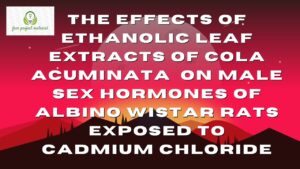TABLE OF CONTENTS
Title Page- – – – – – – – – – i
Certification- – – – – – – – – ii
Dedication- – – – – – – – – – iii
Acknowledgements- – – – – – – – iv
Table of Contents- – – – – – – – – v-vi
CHAPTER ONE
1.0 Introduction- – – – – – – – 1-2
CHAPTER TWO
2.1 Literature Review- – – – – – – – 3-4
2.2 Botanical Classification of Lasianthera Africana– – – 4
2.3 Uses of Lansianthera africana leaves- – – – – 5
2.4 Phytochemical Composition of Lasianthera
africana Leaf- – – – – – – – 5-6
2.4.1 Flavonoids- – – – – – – – – 6-7
2.4.2 Phenolic Acids- – – – – – – – 7-8
2.4.3 Terpenoids- – – – – – – – – 8-9
2.4.4 Alkaloids- – – – – – – – – 9-10
2.4.5 Tannins- – – – – – – – – 10
2.4.6 Saponins- – – – – – – – – 11-12
CHAPTER THREE
3.1 Nutritional Benefit of Lansianthera Africana– – – 13-14
3.1.1 Carbohydrates- – – – – – – – 14-15
3.1.2 Proteins- – – – – – – – – 15
3.1.3 Crude Fibre- – – – – – – – 15-16
3.1.4 Crude Fats- – – – – – – – – 16
3.1.5 Calcium (Ca)- – – – – – – – 16-17
3.1.6 Sodium (Na)- – – – – – – – 17-18
3.1.7 Potassium (K)- – – – – – – – 19-20
3.1.8 Magnesium (Mg)- – – – – – – – 20-21
3.1.9 Iron (Fe)- – – – – – – – – 21-22
CHAPTER FOUR
4.0 Summary and Conclusion- – – – – – 23
4.1 Summary- – – – – – – – – 23-24
4.2 Conclusion- – – – – – – – – 24-25
References
CHAPTER ONE
1.0 Introduction
The nutritional benefits of plants are increasingly tremendous in the world today due to their unrestrained role in human health and constituent active ingredients. Vegetable are fresh edible portion of herbaceous plants which can be eaten raw or cooked and act as important sources of protective food (Sheela et al., 2004).
Interestingly, plant produce food in the leaves, but do not store these food in the leaves. The significance of leafy vegetable have immensely been manifested in human diet supplying the body with low calories, substantial amount of carbohydrates, oil, minerals, vitamins and act as precursors of hormones as well as protein and energy (Adernipekun and Oyetunyi, 2010).
The elicitation of these properties by vegetables are heed greatly to the biological active substances possessed by them such as secondary metabolites, high vitamin and mineral contents. They equally help in the amelioration and prevention of diseases (Ugbogu et al., 2016).
Lasianthera africana (Editan) belong to the order celestraces which comprises thirteen families of trees and shrubs with simple leaves. It belong to the family, icacenaceae and it is locally called “Editan” in Akwa Ibom State, Nigeria. L. africana is consumed as vegetable in South-Eastern State of Nigeria. It is commonly used as antacid, analgesic, antiplasmodic, laxative, antipyretic, antichlorgenic, antidiabetic and antimalarial (Ekanem, 2006). The leaf extract has been reported to contain alkaloids, terpenes, saponins, tannins, flavonoids, anthraquinones and cardiac glycosides with LD50 value of 500 mg /kg (Okokon et al., 2007).
In recent years, herbal prescription have received considerable attention as an alternative way to compensate for perceived deficiencies in orthodox pharmacotherapy world wide (Arika et al., 2015). Despite a lack of medical evidence to support their therapeutic efficacy and toxicological effects, the use of herbal medicine has increased considerably (Arika et al., 2015).

